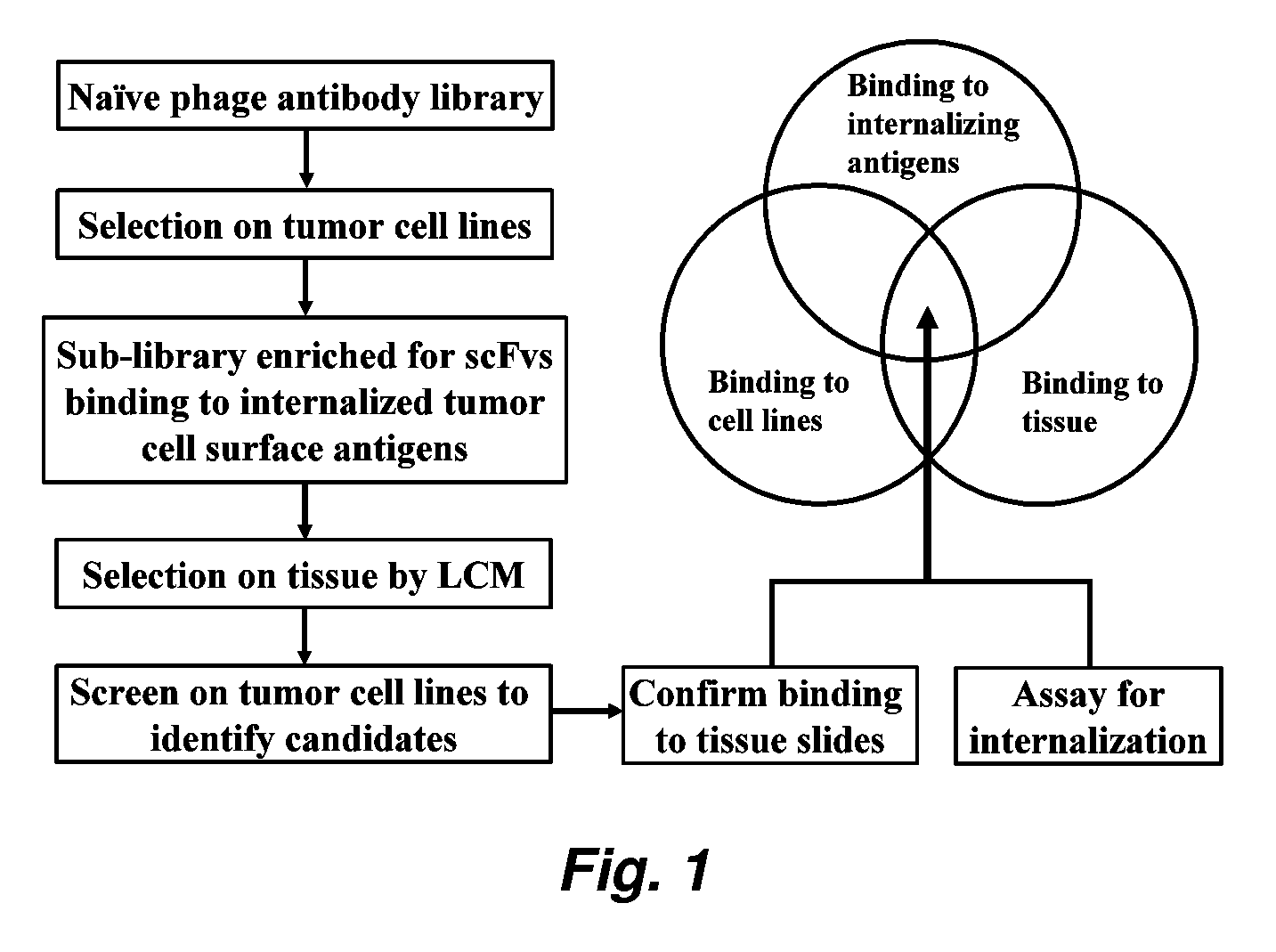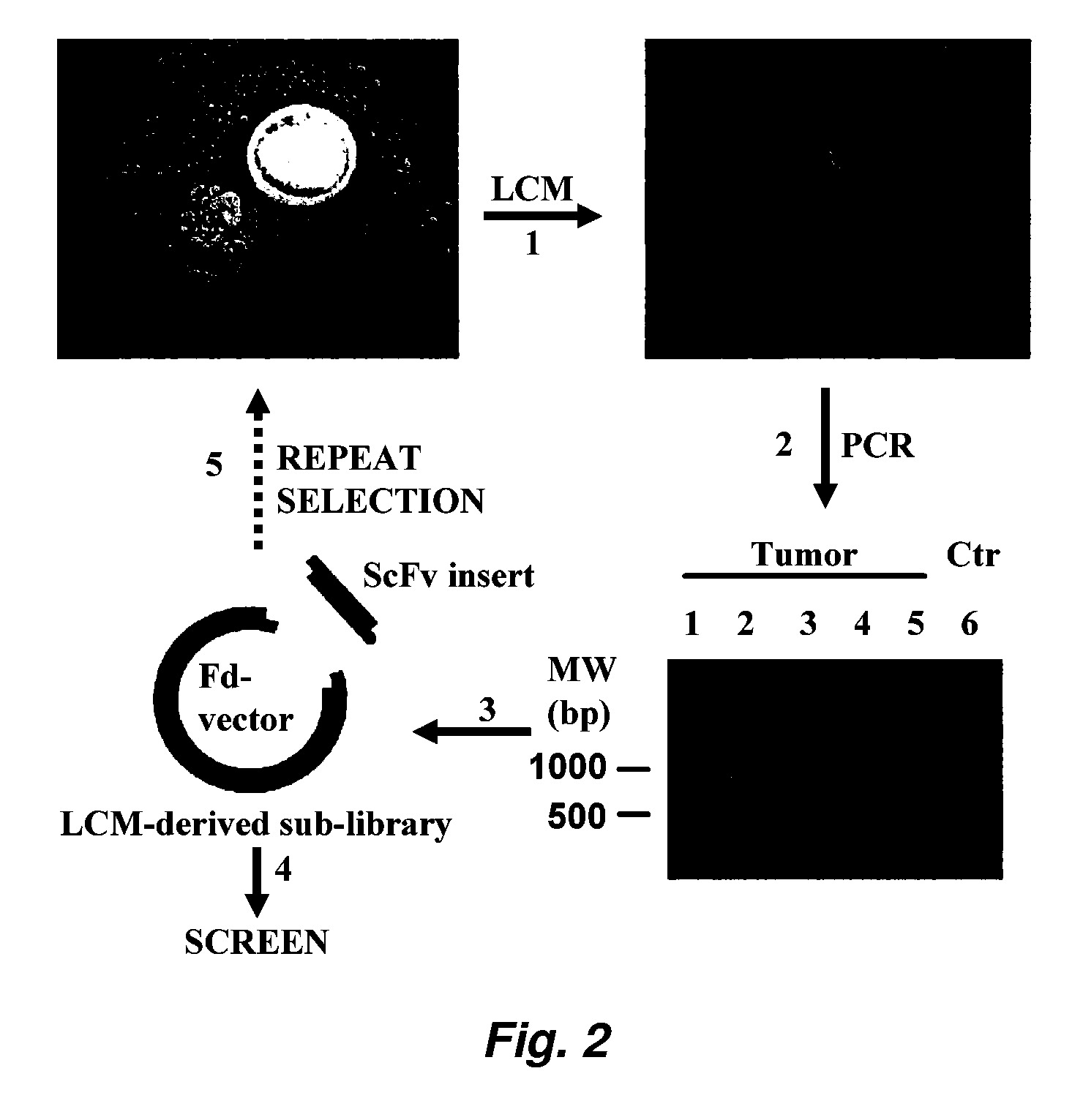Internalizing human monoclonal antibodies targeting prostate cancer cells in situ
a human monoclonal antibody and prostate cancer technology, applied in the field of antibodies, immunodiagnostics, immunotherapeutics, can solve the problems of not providing an ideal picture of how specific these antibodies are, seemingly posing a serious obstacle to selection methods, etc., to facilitate the addition of additional moieties and increase the stability and half-life of such molecules
- Summary
- Abstract
- Description
- Claims
- Application Information
AI Technical Summary
Benefits of technology
Problems solved by technology
Method used
Image
Examples
example 1
Identification of Clinically Significant Tumor Antigens by Selecting Phage Antibody Library on Tumor Cells in Situ Using Laser Capture Microdissection
Experimental Procedures
[0208]Creating a Sublibrary Enriched for Binders to Functional Tumor Cell Surface Epitopes
[0209]A sublibrary was created by selecting a naïve phage antibody display library on a panel of tumor cell lines under internalizing conditions. The preparation and selection of a phage antibody display library has been described previously (Liu et al. (2004) Cancer Res. 64: 704-710; Poul et al. (2000) J. Mol. Biol. 301: 1149-1161). Briefly the phage library was preincubated with a panel of non-tumorigenic cells including BPH-1, human mammary epithelial cells, MCF10A, and human fibroblasts to remove binders to common cell surface antigens. The predepleted library was then incubated with a panel of prostate cancer cell lines (PC3 and Du-145) at 37° C. for 2 h; washed twice with 100 mM glycine, pH 2.8, in the presence of 150 ...
example 2
SPECT / CT and Biodistribution Study of UA20 scFv
[0246]To determine the efficiency of the UA20 scFv in tumor targeting in vivo, we performed molecular imaging studies with technetium (99mTc)-labeled scFv and a combined modality SPECT / CT, which allows simultaneous tomographic imaging of gamma-emitting radiopharmaceuticals and anatomic imaging with CT. Immunodeficient mice were injected with 1 million Du-145 cells subcutaneously. Six days later when the tumor was palpable, the mice were injected with either 99mTc-labeled UA20 scFv or a 99mTc-labeled control scFv (N3M2) and imaged with SPECT / CT, and imaged 3 h post injection. As shown in FIG. 9, prostate cancer xenograft was recognized by 99mTc-labeled UA20 scFv but not the control scFv, demonstrating the targeting specificity in vivo. The other organs that showed the greatest contrast were the kidneys, consistent with the route of scFv excretion from the body.
[0247]Next, we performed biodistribution studies using the 99mTc-labeled UA20 ...
example 3
Additional Comments Regarding Antibodies
[0250]The H3 sequence is identical to clone # 11 (not 10; differing by one a.a.). H3 is 585II41.1. KD data for H3 is shown in FIG. 11 (KD=4.4 μM). To further clarify, 585II41 antibody binds to ALCAM, and is a variant of 585II41.1 that is H3. 585II41 and 585II41.1 have identical properties despite a one amino acid difference.
[0251]The Examples provided above are correct as 585II41 (clone #10) binds to ALCAM. It just that it is not exactly H3, which is 585II41.1 (clone #11).
[0252]It is understood that the examples and embodiments described herein are for illustrative purposes only and that various modifications or changes in light thereof will be suggested to persons skilled in the art and are to be included within the spirit and purview of this application and scope of the appended claims. All publications, patents, and patent applications cited herein are hereby incorporated by reference in their entirety for all purposes.
PUM
| Property | Measurement | Unit |
|---|---|---|
| Fraction | aaaaa | aaaaa |
| Fraction | aaaaa | aaaaa |
| Fraction | aaaaa | aaaaa |
Abstract
Description
Claims
Application Information
 Login to View More
Login to View More - R&D
- Intellectual Property
- Life Sciences
- Materials
- Tech Scout
- Unparalleled Data Quality
- Higher Quality Content
- 60% Fewer Hallucinations
Browse by: Latest US Patents, China's latest patents, Technical Efficacy Thesaurus, Application Domain, Technology Topic, Popular Technical Reports.
© 2025 PatSnap. All rights reserved.Legal|Privacy policy|Modern Slavery Act Transparency Statement|Sitemap|About US| Contact US: help@patsnap.com



